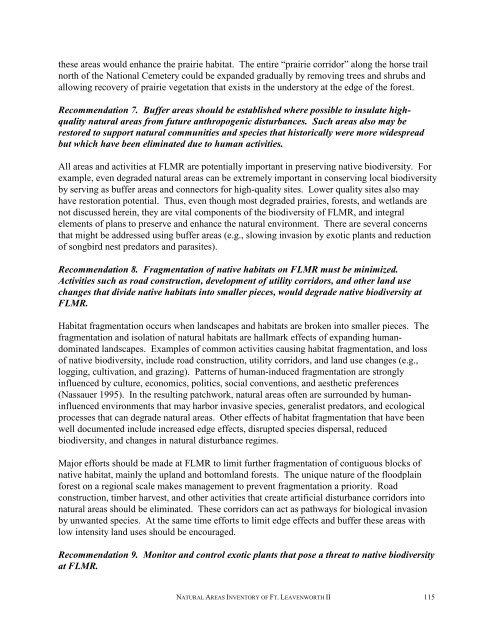A Natural Areas Inventory of the - Kansas Natural Heritage Inventory ...
A Natural Areas Inventory of the - Kansas Natural Heritage Inventory ...
A Natural Areas Inventory of the - Kansas Natural Heritage Inventory ...
You also want an ePaper? Increase the reach of your titles
YUMPU automatically turns print PDFs into web optimized ePapers that Google loves.
<strong>the</strong>se areas would enhance <strong>the</strong> prairie habitat. The entire “prairie corridor” along <strong>the</strong> horse trail<br />
north <strong>of</strong> <strong>the</strong> National Cemetery could be expanded gradually by removing trees and shrubs and<br />
allowing recovery <strong>of</strong> prairie vegetation that exists in <strong>the</strong> understory at <strong>the</strong> edge <strong>of</strong> <strong>the</strong> forest.<br />
Recommendation 7. Buffer areas should be established where possible to insulate highquality<br />
natural areas from future anthropogenic disturbances. Such areas also may be<br />
restored to support natural communities and species that historically were more widespread<br />
but which have been eliminated due to human activities.<br />
All areas and activities at FLMR are potentially important in preserving native biodiversity. For<br />
example, even degraded natural areas can be extremely important in conserving local biodiversity<br />
by serving as buffer areas and connectors for high-quality sites. Lower quality sites also may<br />
have restoration potential. Thus, even though most degraded prairies, forests, and wetlands are<br />
not discussed herein, <strong>the</strong>y are vital components <strong>of</strong> <strong>the</strong> biodiversity <strong>of</strong> FLMR, and integral<br />
elements <strong>of</strong> plans to preserve and enhance <strong>the</strong> natural environment. There are several concerns<br />
that might be addressed using buffer areas (e.g., slowing invasion by exotic plants and reduction<br />
<strong>of</strong> songbird nest predators and parasites).<br />
Recommendation 8. Fragmentation <strong>of</strong> native habitats on FLMR must be minimized.<br />
Activities such as road construction, development <strong>of</strong> utility corridors, and o<strong>the</strong>r land use<br />
changes that divide native habitats into smaller pieces, would degrade native biodiversity at<br />
FLMR.<br />
Habitat fragmentation occurs when landscapes and habitats are broken into smaller pieces. The<br />
fragmentation and isolation <strong>of</strong> natural habitats are hallmark effects <strong>of</strong> expanding humandominated<br />
landscapes. Examples <strong>of</strong> common activities causing habitat fragmentation, and loss<br />
<strong>of</strong> native biodiversity, include road construction, utility corridors, and land use changes (e.g.,<br />
logging, cultivation, and grazing). Patterns <strong>of</strong> human-induced fragmentation are strongly<br />
influenced by culture, economics, politics, social conventions, and aes<strong>the</strong>tic preferences<br />
(Nassauer 1995). In <strong>the</strong> resulting patchwork, natural areas <strong>of</strong>ten are surrounded by humaninfluenced<br />
environments that may harbor invasive species, generalist predators, and ecological<br />
processes that can degrade natural areas. O<strong>the</strong>r effects <strong>of</strong> habitat fragmentation that have been<br />
well documented include increased edge effects, disrupted species dispersal, reduced<br />
biodiversity, and changes in natural disturbance regimes.<br />
Major efforts should be made at FLMR to limit fur<strong>the</strong>r fragmentation <strong>of</strong> contiguous blocks <strong>of</strong><br />
native habitat, mainly <strong>the</strong> upland and bottomland forests. The unique nature <strong>of</strong> <strong>the</strong> floodplain<br />
forest on a regional scale makes management to prevent fragmentation a priority. Road<br />
construction, timber harvest, and o<strong>the</strong>r activities that create artificial disturbance corridors into<br />
natural areas should be eliminated. These corridors can act as pathways for biological invasion<br />
by unwanted species. At <strong>the</strong> same time efforts to limit edge effects and buffer <strong>the</strong>se areas with<br />
low intensity land uses should be encouraged.<br />
Recommendation 9. Monitor and control exotic plants that pose a threat to native biodiversity<br />
at FLMR.<br />
NATURAL AREAS INVENTORY OF FT. LEAVENWORTH II 115


